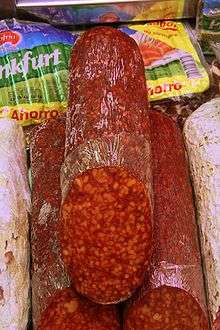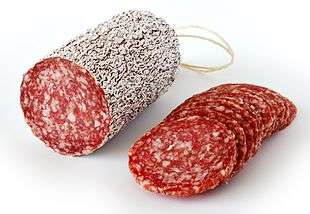Chorizo de Pamplona
Chorizo de Pamplona is a sausage that is typical in the cuisine of the Navarre region of Spain It is prepared with equal parts of finely-chopped beef and pork and significant amounts of a strong smoked paprika, pork fat and[1] a natural or plastic casing which is designated to have a minimum size of forty millimeters in diameter. The red-orange coloration is due to the addition of paprika, which is abundant in Navarre. Despite its local name, it is a very common type of sausage in delicatessens around the Spanish territory. It is also produced and sold in Pamplona, Spain.[2]

Characteristics
Chorizo de Pamplona is a fermented, cured and dried sausage,[1][3] and its texture is typically dry.[4] It has been described as having similar qualities to that of pepperoni sausage. Its flavor has been described as tangy, salty, and as having a slight bitterness derived from the pimentón (Spanish smoked paprika) used in its preparation.[5]
See also
References
- Sausage (in German). DK Publishing. 2012. p. 68. ISBN 978-1-4654-0092-5. Retrieved March 19, 2015.
- Facaros, D.; Pauls, M. (2008). Bilbao and the Basque Lands. CADOGAN GUIDES. Cadogan Guides. p. 213. ISBN 978-1-86011-400-7.
- Toldr?, F. (2010). Handbook of Meat Processing. Wiley. p. 213. ISBN 978-0-8138-2096-5.
- Goldstein, J.; Beisch, L. (2013). Tapas: Sensational Small Plates From Spain. Chronicle Books LLC. p. 24. ISBN 978-1-4521-2667-8.
- Birdsall, John (April 25, 2007). "A Spanish Sandwich". East Bay Express. Retrieved March 19, 2015.
Further reading
- Mehta, B.M.; Kamal-Eldin, A.; Iwanski, R.Z. (2012). Fermentation: Effects on Food Properties. Chemical & Functional Properties of Food Components. Taylor & Francis. pp. 324–325. ISBN 978-1-4398-5334-4.
